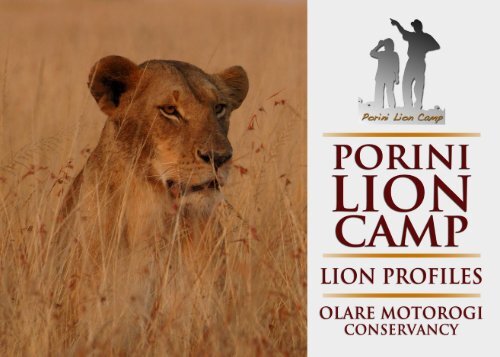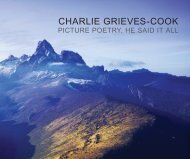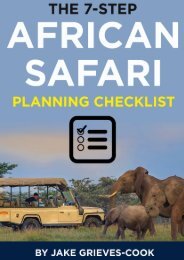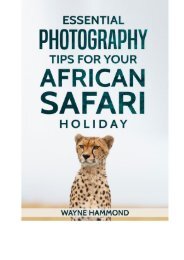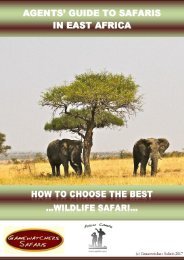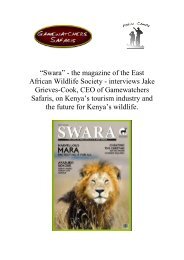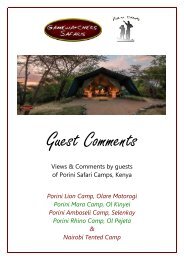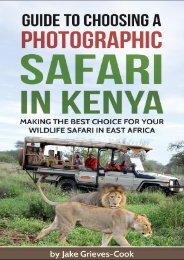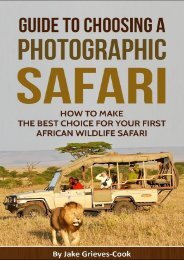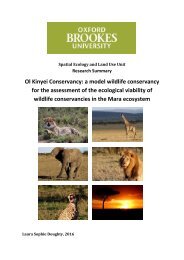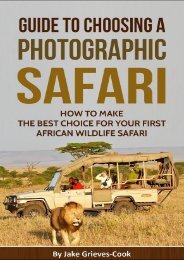Lion Profiles: Olare Motorogi Conservancy
You also want an ePaper? Increase the reach of your titles
YUMPU automatically turns print PDFs into web optimized ePapers that Google loves.
Gamewatchers Safaris and Porini Camps have been committed to<br />
responsible tourism for over 25 years and are a member of the<br />
Kenya Association of Tour Operators. All guides are accredited by<br />
the KPSGA (Kenya Professional Safari Guide Association) and many<br />
are at silver level. This means that they have the skills and<br />
experience to view animals responsibly, giving them the space and<br />
privacy to carry out their natural behaviours. On night game drives,<br />
red filters are used on spotlights to avoid dazzling the animals.<br />
Within the <strong>Conservancy</strong> there is also a restriction of one vehicle per<br />
1,400 acres.<br />
All of the Porini Camps, situated inside private conservancies, are<br />
small, eco-friendly tented camps that accommodate a maximum of<br />
20 guests. Each camp each consist of just 6 to 10 spacious tents in<br />
beautiful natural settings under acacia trees.<br />
You can read more about these conservancies overleaf.<br />
Gamewatchers Safaris & Porini Camps were founded by Jake<br />
Grieves-Cook, a long-time safari operator and supporter of wildlife<br />
conservation in Kenya. Jake has served on the board of the Kenya<br />
Wildlife Service which runs the country’s national parks, and for<br />
six years was Chairman of Kenya’s National Tourist Board. The<br />
company’s CEO is Dr Mohanjeet Brar, whose family has been in<br />
Kenya for five generations.<br />
The vision behind Porini camps, and the private conservancies<br />
within which they lie, is unique. It is a partnership between the<br />
local community and a commercial safari operator, where both<br />
parties’ goals are aligned. As such, we do not depend upon donor<br />
funding.<br />
We believe that one of the keys to our success is recognizing that<br />
the community must derive fair benefits from tourism and must<br />
not be taken advantage of.
In Kenya, Gamewatchers pioneered the “conservancy concept” – the leasing of land to form<br />
community-owned wildlife conservancies adjacent to national parks. They started with<br />
Selenkay <strong>Conservancy</strong> in the Amboseli eco-system in the 1990s, then Ol Kinyei <strong>Conservancy</strong><br />
in the Masai Mara in 2005. In May 2006, Gamewatchers then played a pivotal role in the<br />
creation of <strong>Olare</strong> <strong>Motorogi</strong> <strong>Conservancy</strong> (OMC) adjacent to the Masai Mara National<br />
Reserve (MMNR), followed by the adjoining Naboisho <strong>Conservancy</strong>. The development of<br />
these conservancies was critical to ensuring the protection of wildlife habitat beyond<br />
officially protected areas and they have since contributed to a significant regeneration of<br />
wildlife populations including elephants and all the big cats. OMC was recently shown to<br />
support Kenya’s highest density of lions outside of the Mara Reserve.<br />
Within <strong>Olare</strong> <strong>Motorogi</strong> <strong>Conservancy</strong>, wildlife tourism is limited and strictly controlled. This<br />
means that animals are not disturbed by vehicles and habitats remain pristine. Cattle grazing<br />
is also managed to benefit both people and wildlife, which means that, together with efforts<br />
such as improvements to “bomas” (cattle corrals) and patrols by ranger teams, humanwildlife<br />
conflict is much reduced. Rotational grazing helps control grass height and prevents<br />
overgrazing, thus attracting a diverse range of herbivores including the spectacular annual<br />
migration.<br />
The formation of the OMC and other conservancies has brought financial advantages to local<br />
people. Over 200 members of local communities work directly with Gamewatchers Safaris &<br />
Porini Camps. Over 500 families earn a steady monthly income from leasing land inside the<br />
conservancies to tourism safari camps. Crucially, this means that wildlife tourism provides a<br />
sustainable source of income for land owners, ensuring that this form of land use is a viable<br />
option as an alternative to others such as agriculture and development which may cause<br />
habitat loss and human-wildlife conflict. Without the conservancies, it is likely that local<br />
wildlife would be significantly threatened by habitat loss and human-wildlife conflict and<br />
restricted to the Mara Reserve. OMC is managed by Olpurkel Ltd, a not-for-profit company,<br />
on behalf of the landowners and tourism partners, while the Maa Trust receives donations<br />
from the tourism partners to support community projects.
We identify lions from the whisker spot pattern. This is<br />
unique to each individual, and, unlike other features, remain<br />
unchanged throughout a lion’s life. This means that we can<br />
recognize lions as they age despite other changes in their<br />
physical appearance.<br />
Ear tears are permanent and<br />
can be used to identify lions.<br />
However, new tears may<br />
appear with age.<br />
A male’s mane will change,<br />
and is therefore not used to<br />
identify individual lions. We<br />
can, however, use manes to<br />
estimate the age of a lion.<br />
This image shows how the<br />
spot pattern is used; by<br />
measuring the position of<br />
the identification spots in<br />
relation to the position of<br />
the reference row spots<br />
(the top complete row of<br />
spots). We start counting<br />
at the nose, measuring<br />
past spots, not before.<br />
Missing tail tips, broken teeth and cut noses are<br />
common injuries that can be used to identify lions.<br />
Scars and scratches should not be used to identify<br />
lions. These are rarely permanent, unless they are<br />
from a major injury (far right).<br />
The spot diagram (below)<br />
is shown on each lion’s<br />
profile card together with<br />
other key features.<br />
Young lions have a pink nose<br />
which changes with age. At<br />
2-4 years, black spots<br />
appear, growing to form<br />
patches by age 5-7. By 8-9<br />
years, the nose is usually<br />
black. We can use this to<br />
both age and identify lions.
✓<br />
✓<br />
✓<br />
✓<br />
✓<br />
✓<br />
&<br />
`<br />
`<br />
It is much easier to use your camera to zoom in to these features to<br />
identify lion than studying them directly in the field!<br />
<strong>Lion</strong>s are best identified from clear, sharp photographs showing the left<br />
and right whisker spots. As the spot pattern will change with the image<br />
angle, it is important to take shots at a 90 degrees to the lion’s face.<br />
Good photographs may also show the any of the identifying features<br />
shown opposite, including the ears, nose, mane and teeth.<br />
Everyone can take good<br />
lion photos, especially in<br />
the Mara where they are<br />
easily approached.<br />
Closeup shots are ideal<br />
wide shots can show<br />
other identifiable pride<br />
members to help identify<br />
the lion in question.<br />
This booklet contains profiles of<br />
the key Enkoyonai and Oldikidik<br />
pride members. It can be used to<br />
identify lions in the field or in the<br />
comfort of camp if you have<br />
taken photos on a digital camera.<br />
Ask your guide if you need help<br />
identifying which pride you have<br />
been watching.
The Enkoyonai Pride are so named after the spring where there are often<br />
found. They used to be a very large pride but have now split to find new<br />
territories within the conservancy. Four females form the core of the pride,<br />
together with their five young offspring. They are often joined by the two<br />
conservancy males, Olbarnoti and Lolparpit.
Selenkei is an one of the older females from the<br />
Enkoyonai Pride. Her name means a ‘girl who has<br />
reached maturity’. She has a patchy nose and<br />
distinctive tears in her left ear. These can be used to<br />
identify her along with her whisker spots.<br />
2007
Nashipai is an older female a female from the<br />
Enkoyonai Pride. She has a black patchy nose, sharp<br />
features and a characteristic right ear. She has a mid<br />
spot on the right side. She is most often seen with<br />
the main Enkoyonai group.<br />
2006
Naibor means ‘white’ - her coat is unusually white.<br />
She has a small face and a patchy nose. She also has<br />
a characteristic double tear in her left ear and a<br />
chunk from the right ear. She is one of the older<br />
lionesses of the pride and is often seen with the<br />
main Enkoyonai group.<br />
2007
Napono is a young lioness from the Enkoyonai Pride<br />
and the daughter of Nashipai. She can be identified<br />
from her whisker spots and the characteristic tears<br />
in her right ear. She has a pink nose but this will<br />
develop spots as she matures.<br />
2015
Napono is a young lioness from the Enkoyonai Pride<br />
and the daughter of Nashipai. She has very<br />
characteristic whisker spots which can be used to<br />
identify her from other lionesses. She also has small<br />
neat ears and some characteristic spots on her nose,<br />
although these spots may change as she matures.<br />
2015
Chumvi is a young male from the Enkoyonai Pride.<br />
He is likely to be a son of Mohican or Romeo II. As he<br />
matures he will leave the pride. He can be identified<br />
from has brother, Pilipili, by the characteristic tear in<br />
his right ear. He has an out of place whisker spot<br />
under the third spot on the second row.<br />
2015
Tatu is a young male lion from the Enkoyonai Pride<br />
and is likely to be the son of Olbarnoti. As he<br />
matures he will leave the pride. He can be identified<br />
from his brother, Chumvi, by the three whisker spots<br />
on each side of his face and lack of a distinctive tear<br />
in his right ear.<br />
2015
Female #4 is a young lioness from the Enkoyonai<br />
Pride and has four sisters. She has a characteristic<br />
tear in her left ear and some serrated marks in her<br />
right ear. She also has some characteristic whisker<br />
spots oh her left side including a mid spot under the<br />
reference row. These can be used to distinguish her<br />
from her sisters and similar lionesses.<br />
2015<br />
Images ©<br />
Peter Rettig
Female #5 is a young lioness from the Enkoyonai<br />
Pride and has four sisters. She has few identifying<br />
characteristic so it is important to study her whisker<br />
spots in order to distinguish her from other<br />
lionesses. She is likely to develop more identifying<br />
features such as ear tears and nose spots as she<br />
matures.<br />
2015<br />
Images ©<br />
Peter Rettig
The ‘Oldikidik’ Pride are a split from the old Moniko Pride who have now<br />
dispersed around the conservancy. Once totalling over 30, the Moniko Pride<br />
has had to split up into smaller groups in order for them to hunt successfully.<br />
The sub-group of the Oldikidik Pride is now formed from several young core<br />
females and their cubs. They are often joined by the pride males Olbarnoti<br />
and Lolparpit.<br />
`
Sila is an young adult female from the Oldikidik<br />
pride. She has some small tears in her right ear and<br />
one large identification spot at the back of her left<br />
whiskers. This can be used to identy her from other<br />
lionesses in the pride.<br />
2013
`<br />
Nasieku is one of the older females of the Oldikidik<br />
Pride, but is still a relative youngster. She has a<br />
patchy nose indicating that she is older than most of<br />
the other lionesses in the pride. Her whisker spots<br />
should ideally be used to identify her.<br />
2011
Nabiki is one of the older lionesses of the Oldikidik<br />
pride, but is still a relative youngster. She has a<br />
distinctive notch in her right ear that can be used to<br />
identify her, along with a large identification whisker<br />
spot at the rear of her right whiskers. She is a likely<br />
sister of Nasieku.<br />
2011
Nasha means ‘playful’. She is often seen playing with<br />
the pride cubs. She is a young lioness and a likely<br />
sister of Sila. Whilst she looks similar to Sila, her<br />
right-side identification whisker spots can help to<br />
distinguish her from her. The few spots on her nose<br />
will continue to grow in size and number.<br />
2013
Lolparpit means ‘lots of hair’. Unlike Olbarnoti, his<br />
ears are usually covered by his larger mane. He can<br />
also be distinguished from his partner Olbarnoti by<br />
his left whisker spots. Be careful as the tear in his<br />
right ear is similar to Olbarnoti’s ear tear, but is less<br />
pronounced.<br />
2005
Olbarnoti means ‘smaller boy’ - his mane is smaller<br />
than that of his partner Lolparpit. He can also be<br />
distinguished from Lolparpit by the characteristic<br />
tear in his right ear. He has a large identification<br />
whisker spot on the left side, but as with many male<br />
lions, his scars can make this hard to see.<br />
2005


